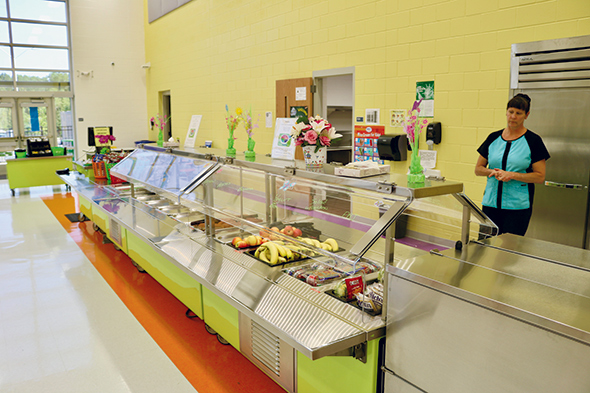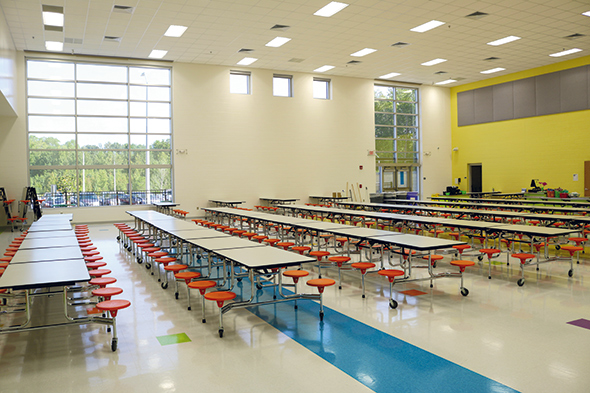This Garner, N.C., school brings a fresh, healthful approach to foodservice, while acting as a swing school for Vandora Springs Elementary.
One of the fastest-growing school districts in the country, Wake County Public School System (WCPSS) in North Carolina reports that student enrollment has increased 40 percent over the past 13 years. To keep pace with this growth, the district has built new schools, improved old schools and found creative ways to provide the learning space students need.
 The serving line displays both hot and cold menu items.
The serving line displays both hot and cold menu items.
One of the new builds, Bryan Road Elementary in Garner, N.C., currently serves as a swing school, a space built to temporarily house students and faculty from a preexisting school. For example, students and faculty from Vandora Springs Elementary will go to Bryan Road Elementary while their preexisting school undergoes a renovation. Once Vandora Springs reopens in 2018, Bryan Road will continue to operate, opening as a new school and bringing in students based on the district's student assignment process.
"Bryan Road is the 14th use of a prototype for Wake County Public Schools but has unique and new features such as a new learning commons for each grade level that allows students to come together and work on projects to support needs they have to be successful in the 21st century," says Donna Francis, AIA, ALEP, LEED AP BD+C, architect at Clark Nexsen in Raleigh, N.C. Like other schools, Bryan Road must be built to last about 50 years.
In addition to a leading-edge academic environment, Bryan Road also brings a fresh, healthful approach to foodservice. A combination of natural and energy-efficient lighting work collaboratively to contribute to a colorful dining area. The design of the kitchen and servery allows staff flexibility in selecting and displaying menu items. Students can easily move along the service lines and select their favorite menu items.
 Floor-to-ceiling windows bring in natural light to brighten the dining room.
Floor-to-ceiling windows bring in natural light to brighten the dining room.
Back-of-House Production
When food deliveries arrive, staff take them along a straight, unobstructed path to a walk-in freezer, walk-in cooler and dry storage. A nearby two-door, reach-in refrigerator also holds menu items. "These areas provide easy access for staff and reduce time retrieving products," says Paula De Lucca, MSMOB, SNS, senior director of Child Nutrition Services, WCPSS. Lockers and breakdown spaces sit close to the back entrance so staff can easily access them. The central location of the manager's office allows her to monitor all production.
Preparation and assembly of daily menu offerings take place at several separate workstations. "The key to efficiency throughout the operation is a sensible workflow in the kitchen," De Lucca says.
"When food comes out of cold storage, we don't have to zigzag it around the kitchen. Rather, food is taken out of storage and everything is placed on carts and taken to stations for preparation," says Meg Strong, administrator/area supervisor. She is responsible for several schools and is the child nutrition services lead on construction and facilities-related projects.
Staff use a 12-quart mixer for combining ingredients for muffins and crumbles for fruit crisps. A designated cabinet holds proofed and baked goods. Staff work with a food processor to cut, dice and combine vegetables and a slicer to cut meats and cheese. The culinary team thaws frozen menu items in the morning and then, just in time for breakfast and lunch service, they heat the food with any of the following equipment: a convection steamer, two convection ovens and double-stack micro-steamers.
"We tested a micro-steamer at a middle school and loved it," says Kim Harmon, the administrator/area supervisor responsible for several schools and equipment testing, purchasing and oversight for WCPSS. "The micro-steamer cooks faster than a regular steamer. For instance, our mac and cheese comes in five-pound packages. A regular steamer would take 25 to 30 minutes to cook from the frozen state to our desired temperature. But the micro-steamer takes only five minutes."
 Steamers, convection ovens and microwave ovens enable staff to heat a variety of menu items.
Steamers, convection ovens and microwave ovens enable staff to heat a variety of menu items.
Staff use the commercial-grade micro-steamers to meet supplemental preparation needs. "The primary objective is to have capability to quickly heat menu items when standard ovens prevent rapid line replenishment," De Lucca says. "This allows us to virtually eliminate customer wait time and waste associated with unpredictable customer preferences."
After preparation, child nutrition assistants place menu items on pass-through rolling racks and place racks into the cooler. Staff remove the racks from the cooler as needed and heat the menu items in steamers or ovens.
Also in the back of the house, the warewashing area sits along one wall and contains a four-compartment and three-compartment pot-washing sink and a mobile drying rack. Students eat their meals using disposables and recyclables, thus eliminating the need for a dishwasher.
Front-of-the-House Production
In the front of the house, De Lucca says the challenge is "to get kids in and quickly through the service lines. They have 30 minutes for lunch, so they need time to get through the line, eat and relax."
 Steamers, convection ovens and microwave ovens enable staff to heat a variety of menu items.
Steamers, convection ovens and microwave ovens enable staff to heat a variety of menu items.
Offering enough choices to please students presents another challenge. Straight (rather than L-shaped) serving lines maximize use of space and eliminate awkward access for students. A separate, mobile condiment cart enables staff to move these ingredients easily from the kitchen to the serving lines and eliminates the need for frequent restocking.
The two serving lines contain wells that can quickly switch from hot to cold or frozen. That line design eliminates the need for added ice in cold sections. "This equipment feature gives us the flexibility to adjust the lines according to the menu items served on any given day," De Lucca says. One line spans 60 inches, containing 5 wells, and the other spans 48 inches and contains 4 wells. Students must take three of five items, and one must be a fruit or vegetable. Staff assist students with their choices. Labels clearly detail what students must put on their plates to meet the reimbursable meals guidelines.
At Bryan Road, digitalized hoods and utility distribution systems help staff monitor which pieces of equipment are in use and which are not, so they can adjust as needed.
Learning from Other Projects
"We learn from other projects," says Strong. "We liked the plan for another school, but for Bryan Road, we tweaked the plan to give it more aisle space so staff can move more easily through the space." More aisle space made it possible to bring in the roll-throughs and micro-steamers.
Getting good results for new builds and renovation projects requires staff oversight and supervision. "We learned that you have to know what you want and be firm about getting it," says Strong. "We check everything, including the width of aisles and walking space and the size of the coolers. We continually communicate with the architects to be sure we're getting what we need."
Facts of Notes
- Wake County Public School System: 183 schools; enrollment, 160,000 students; district growth at 40 percent since 2004–2005 school year
- Vandora Springs at Bryan Road Elementary: Enrollment, 516 students; 330 daily lunch meal equivalents; 291 are eligible for free/reduced price meals
- Bryan Road Elementary Cafeteria Opened: April 2017. The 52-classroom school is currently occupied by Vandora Springs Elementary while that campus undergoes renovation; Bryan Road will open for a new student population in fall 2018.
- Scope of Project: New kitchen, cafeteria and dining room in a new school
- Size: School, 109,432 sq. ft.; kitchen (production area), 1,020 sq. ft.; cafeteria (serving line, refrigerator, freezer, dry storage, custodial and lockers), 1,970 sq. ft.; dining room (seating area), 3,640 sq. ft.
- Seats: 288
- Average Meal Cost (for paying students): $1.25 breakfast; $2.35 lunch
- Total Annual Sales: $264,000
- Daily Transactions: Total, approximately 510 per day; 135 at breakfast; 360 at lunch
- Hours: 8 a.m. to 8:30 a.m., breakfast; 10:40 a.m. to 1:05 p.m., lunch
- Menu Specialties: Breakfast: turkey sausage pancake stick, blueberry breakfast corndog, southern chicken filet biscuit, protein-packed breakfast boat. Lunch: spaghetti, grilled honey BBQ rib hoagie, build-your-own nachos, teriyaki beef dippers with seasoned brown rice, pizza, macaroni and cheese
- Staff: 3 full-time equivalents and 1 part-time
- Total Project Cost: School, $29,795,144
- Equipment Investment: Approximately $182,500
- Website: www.wcpss.net/domain/1547
Key Players
- Ownership: Wake County Public School System (WCPSS) Bryan Road Elementary (currently a swing space occupied by Vandora Springs Elementary)
- Principal: Troy Peuler
- Assistant Superintendent for Facilities, WCPSS: Mabry (Joe) Desormeaux
- Senior Facility Planner for WCPSS: Marcella Rorie
- Project Manager, WCPSS Facilities Design and Construction: Ronnie Stott
- Senior Director, Child Nutrition Services, WCPSS: Paula De Lucca, MSMOB, SNS
- Administrators/Area Supervisors, WCPSS: Meg Strong and Kim Harmon
- Manager, Bryan Road Elementary, WCPSS: Beth Carr
- Architect: Clark Nexsen; Raleigh, N.C.; Donna Francis, AIA, ALEP, LEED AP BD+C
- Foodservice Consultant: 11400 Inc.; Lancaster, Penn.; James M. Stephens, president
- Equipment Dealer: Spears & Associates, Clayton, N.C.; Roger Spears, owner
- Construction: New Atlantic Contracting Inc., Winston-Salem, N.C.




